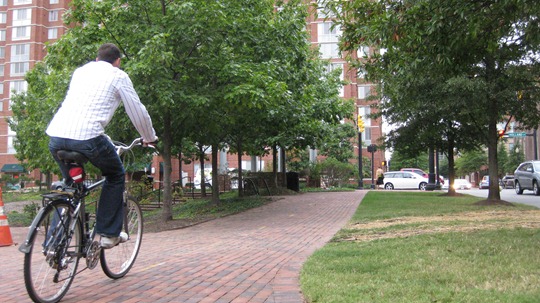Back in March 2009, a mock Nissan commercial surfaced on YouTube that pits Hyundai against Toyota, starring Andy Richter and James Adomian.
I thought a slight change to the ending of the video would be more appropriate. (Hopefully the lawyers over at Nissan are sympathetic to us cyclists).
The video highlights something that we have talked about on The Urban Country over the years. People are always trying to out-do their neighbours – keeping up with the Joneses, as they say – which tends to drive our society to consume more and more.
———————————————————————————————————–
Other “keeping up with the Joneses” articles on theurbancountry.com:
- Redefining Freedom (October 3, 2008)
- The New American Dream (October 19, 2008)
- Middle-Aged Men Powering Through Midlife Crisis (August 11, 2009)
———————————————————————————————————–
Automobile commercials normally do a great job to convince people that they need to upgrade their car every couple years to the newest and greatest model, and many people succumb to this illogic by buying a new car every couple years.
This commercial is different – it highlights how ridiculous “keeping up with the Joneses” really is. It also shows how angry drivers can become when somebody else has an advantage over them (even if it shows a greatly exaggerated and unrealistic response).
When I ride my bicycle in Toronto, I sometimes feel that automobile drivers show animosity toward cyclists – especially during rush hour – simply because cyclists are able to move at a faster pace than their gridlocked automobiles.
It also doesn’t help that there is a perception out there that drivers pay for the roads and thus have more rights to the roads than cyclists. But we have addressed this myth in our “Cyclists Paving the Way for Ungrateful Drivers” article.
I have also found that this animosity can be greatly reduced – by riding at a calm pace, on a sit-up bicycle – though it cannot be eliminated altogether.
Cycling in Virginia by James D. Schwartz / The Urban Country (Sept. 2009)
When I first saw the Nissan commercial, I thought it would make a great commercial to promote cycling – but unfortunately it ended with the Nissan driver avoiding the battle between the Toyota and the Hyundai. (Because the Nissan is of course better than both the Toyota and the Hyundai, so the Nissan owner didn’t want to be shot – or so that’s what the commercial wants you to think).
Let’s look at our options here:
| Option | Price | MPG |
| 2009 Hyundai Elantra | $19,500 | 24 |
| 2009 Toyota Prius | $14,500 (with cash back offer) | 36 |
| Standard Commuter Bicycle | Approx. $300 | Unlimited |
I would rather have any old bicycle than a Nissan, Toyota, or a Hyundai. It’s all about forgetting about the Joneses – and having fun and being healthy at the same time!
James D. Schwartz is the editor of The Urban Country. You can view all of James’ articles here.
Other Related Articles:



$300?? The cars are new, so one should compare them with a new commuter bike. $300 will buy you a crappy BSO at Wall-Mart that will fall apart shortly.
A real commuter bike, like a Batavus or Pashley from a real bike shop like Curbside will cost at least three times as much. But it will work. And keep working.
I don’t know about you Kevin, but I wouldn’t want to leave a $900 locked up outside all day while I’m working (assuming of course I didn’t work in an office where I can bring my bike inside).
Sweet Pete’s has a new Trek 7000 for $329.99 – http://www.sweetpetes.com/index.php?page=shop.product_details&flypage=flypage.tpl&product_id=173&category_id=21&option=com_virtuemart&Itemid=1
Quick, what’s the difference between 1-million and 1-billion short scale? 1-million seconds is roughly 11.5 days. 1-billion seconds is 31.6 years.
Why is this pertinent? Because the auto industry spends on the order of US$18.5 to $19.8 billions on advertising ever year.
Moreover, that advertising invariably portrays a single car “flying” down a fantasy roadway “uncluttered” with other cars, traffic controls of any sort, or pedestrians or bicyclists. Actually, the most recent generation of advertising doesn’t even bother to show real cars: Instead, computer graphics are used to portray artistic representations of a given car in surreal movements through materials that don’t even slightly resemble a road at all. In other words, those whose extensive research makes them most familiar with the issues — the automobile industry itself — has determined that the realities of automobile ownership and operation are, at best, unsaleable.
The problem is the effect this preponderance of one-side, fantasy-based, messaging has on transportation policy, and that policy’s fraternal twin, energy policy. Stated another way, what might the world look like if the automobile industry and the public transit sector were to swap advertising budgets for, say, five or even ten years?
Someone made this comment on Reddit:
“The “unlimited” MPG on the bike is disingenuous. It takes energy to move the bicycle, same as it takes energy to walk or drive a car. The chart really should reflect that. The bicycle is far and away the most efficient form of transport known to man, there’s no need to inflate the numbers. It’s just more preaching to the choir.”
I didn’t expect anyone to take my little chart as a scientific comparison. Originally I was going to write “as far as you can pedal”, but I wrote “unlimited” because it takes 0 gallons of gasoline to move a bicycle (and gasoline is typically the subject of the MPG measurement)
This is not a real commercial. This is a commercial parody from The Midnight Show at UCB.